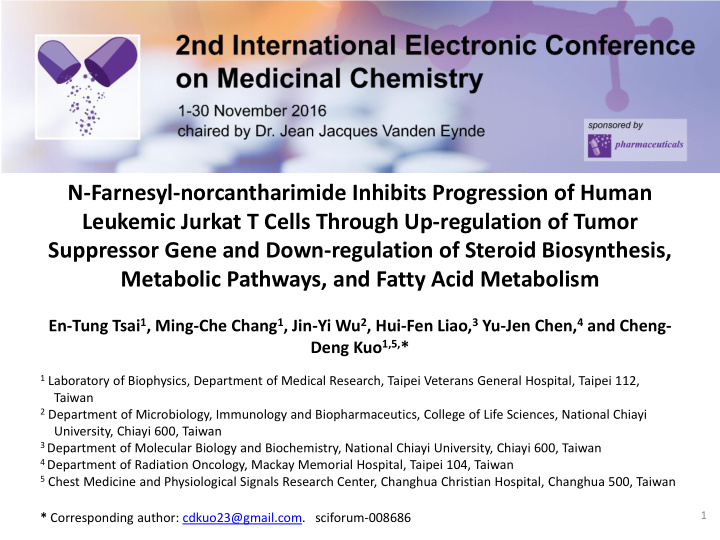



N-Farnesyl-norcantharimide Inhibits Progression of Human Leukemic Jurkat T Cells Through Up-regulation of Tumor Suppressor Gene and Down-regulation of Steroid Biosynthesis, Metabolic Pathways, and Fatty Acid Metabolism En-Tung Tsai 1 , Ming-Che Chang 1 , Jin-Yi Wu 2 , Hui-Fen Liao, 3 Yu-Jen Chen, 4 and Cheng- Deng Kuo 1,5, * 1 Laboratory of Biophysics, Department of Medical Research, Taipei Veterans General Hospital, Taipei 112, Taiwan 2 Department of Microbiology, Immunology and Biopharmaceutics, College of Life Sciences, National Chiayi University, Chiayi 600, Taiwan 3 Department of Molecular Biology and Biochemistry, National Chiayi University, Chiayi 600, Taiwan 4 Department of Radiation Oncology, Mackay Memorial Hospital, Taipei 104, Taiwan 5 Chest Medicine and Physiological Signals Research Center, Changhua Christian Hospital, Changhua 500, Taiwan 1 * Corresponding author: cdkuo23@gmail.com. sciforum-008686
Abstract: N-farnesyl-norcantharimide (C23H33NO3, NC15) can reduce the cell viability and increase the percentage of Jurkat T cells (JKT) in the sub-G1 phase. The NC15 might inhibit progression of JKT cells through the up-regulation of TSG and the down-regulation of steroid biosynthesis, metabolic pathways, and fatty acid metabolism, instead of through apoptosis. Keywords: N-farnesyl-norcantharimide; Jurkat T cells; Apoptosis; Next-generation sequencing; Tumor suppressor gene; Metabolism 2
Introduction: T-ALL and Jurkat T cells (JKT) Acute T lymphoblastic leukemia (T-ALL) is one of the most common childhood cancers with very poor prognosis. Quarters of childhood T-ALL patients relapse within 5 years of treatment and have a dismal prognosis. The Jurkat T (JKT) cell line is an eternalized T cell line which was established from the peripheral blood of a fourteen years old boy with acute T cell leukemia in the late 1970s. 3
Introduction: Cantharidin Mylabris, a species of blister beetle (Mylabris phalerata Pall.), has been used in traditional Chinese medicine for over 2000 years for the treatment of malignant tumors such as hepatoma, breast cancer, colorectal cancer, and abdominal malignancy. Cantharidin (exo-2,3-dimethyl-7-oxabicyclo-[2.2.1]-heptane-2,3- dicarboxylic acid anhydride), one of the active compounds obtained from Mylabris has anti-cancer properties both in vitro and in vivo. Clinical applications of cantharidin are restricted by its side effects in the urinary system and nephrotoxicity. 4
Introduction: Norcantharidin (NCTD) Norcantharidin (NCTD) is currently being used as an anti- cancer drug in China. NCTD is effective towards hepatoma, gallbladder carcinoma, leukemia, and colorectal carcinoma, and can decrease the growth of human HepG2 cell-transplanted tumor in nude mice and prolongs host survival. 5
Introduction: N-farnesyl-norcantharimide (C 23 H 33 NO 3 , NC15) N-farnesyl-norcantharimide (C 23 H 33 NO 3 , designated as NC15), a newly synthesized NCTD derivative, has high anti- cancer activity in cell model, and can induce G2/M arrest and induce cell apoptosis on mouse leukemic L1210 cells. NC15 can increase the survival days of mice and decrease the tumor weight in the syngeneic mouse leukemia model. The anti-cancer mechanism of NC15 is not clear. 6
Introduction: Aims of study To examine the effects of NC15 on cell viability by using cell cycle analysis and Annexin-V apoptosis assay. To investigate the mechanism of anti-cancer effect of NC15 on JKT cells at gene level. 7
Methods: Cell viability of JKT cells after treatment with NC15 was assessed using cell counting Kit-8 method. The IC50 of the NC15-treated JKT cells was estimated using dose – response curve. Flow cytometry analysis and human apoptosis antibody array assay were performed to study whether or not apoptosis is the anti-cancer mechanism of NC15. Whole genome sequencing of NC15-treated JKT cells using next-generation sequencing (NGS) was performed to determine the genes which were up-regulated or down- regulated in the JKT cells after treatment with NC15. 8
Results: NC15 inhibited growth of JKT cells NC15 inhibited the growth of JKT cells in a dose- and time- dependent manner. The IC50 of NC15 in JKT cells at 24 and 48 h was 2.51 and 2.54 μmol /ml, respectively. The inhibition rates of cell viability were about 80% and 95% when the cells were treated with 8 μmol /ml NC15 for 24 and 48 h, respectively. 9
Results: Cell cycle analysis and sub-G1 apoptotic cells NC15 can inhibit cell growth by interfering with cell cycle. NC15 might induce late apoptosis, but not early apoptosis, in JKT cells after NC15 treatment. Apoptosis array suggested that NC15 did not induce apoptosis in JKT cells. The percentages of NC15-treated cells in the sub-G1 phase at 24 h and 48 h were 22.0% and 34.3 %, respectively, in contrast to the 1.5% in the control. 10
Results: Apoptosis assay using Annexin V/PI stain Early/late apoptosis rates were 2.8/0.8, 1.7/1.2, 2.3/1.9, 3.6/1.8, 7.4/2.1 in untreated cells and cells treated with 2, 4, 6, and 8 μmol /ml NC15, respectively. NC15 might induce late apoptosis, but not early apoptosis, in JKT cells. 11
Results: NC15 did not induce apoptosis There were no difference in bad, bax, BID, bcl-2, Caspase- 3, Caspase-8, Cytochrome C, Fas, Fas Ligand, and HSP70 between the untreated and treated cells. NC15 did not induce apoptosis in JKT cells. 12
Results: NC15 affects JKT cells via metabolism & biosynthesis Next-generation sequencing (NGS) of NC15-treated JKT cells (Illumina) showed that the tumor suppressor genes (TSG) CYBA (NADPH), CDKN1B (P27) and ATF4 (CREB3) were up-regulated. The genes for serine metabolism and aminoacyl- tRNA biosynthesis were also up-regulated. 13
Results: NC15 affects JKT cells via metabolism & biosynthesis The genes for steroid biosynthesis, metabolic pathways, and fatty acid metabolism were down- regulated. 14
Conclusions: The NC15 can reduce the cell viability and increase the percentage of cells in the sub-G1 phase. The NC15 might inhibit progression of JKT cells through the up-regulation of TSG and the down-regulation of steroid biosynthesis, metabolic pathways, and fatty acid metabolism, instead of through apoptosis. 15
Acknowledgments: This study was supported by grants V104E5-001 and V104C-153 of the Taipei Veterans General Hospital, Taipei, Taiwan. 16
Recommend
More recommend